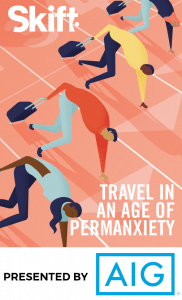Skift Take
Social media brings the world closer and informs us, but it also amplifies the insignificant to the point of crisis when patience would solve the problem better.
Skift launched the latest edition of our magazine at Skift Global Forum in September. This article is an excerpt from our look into the current state of the traveler and consumer mindset through the lens of the pervasive state of anxiety felt worldwide.
Download the full version of Skift’s Travel in an Age of Permanxiety magazine here.
It’s 12:37 a.m. on the taxiway at San Francisco International and I’m rage-tapping my phone, trying to figure out just HOW there can be airport traffic in the middle of the night. Anxiety-refreshing my Twitter feed, I discover passengers on adjacent planes doing the same and venting to @flysfo’s black hole of an account. Every two minutes there’s another update, perhaps one more piece to the puzzle of why we’re stuck.
The widespread use of social media made it magnitudes easier for customers to speak directly to brands and the airline industry over the last few years. It’s now possible to get customer support directly through Twitter, book flights using chatbots on Facebook and provide feedback on broken-down subway trains instantly and directly to New York’s MTA.
Along with the benefits though, it has also dragged out bitter side effects — including anxieties that come along with information over-saturation and infinite online reach.
In no place is this anxiety better shown than when a flight is canceled or delayed. Back when media were slower, passengers only had their companions and neighbors with whom to commiserate. Now, that same 45-minute weather delay can turn even the most friendly and apolitical person with 28 followers into a crusading zealot, threatening to turn his audience against the airlines.
In San Francisco, on the taxiway, I watch stranded travelers lob complaints out into the Twitter ether like ants swimming upstream in the Colorado River. “Stuck on the tarmac at @flySFO for a full hour after landing. Come on, @united! It’s after midnight now, this is absurd #LetUsOffThisPlane” said one @andiatkin, apparently unaware that air traffic control was actually causing the delay.
@MiriamBWilliams chipped in from her marooned flight, adding “@flySFO @VirginAmerica #VX29 on tarmac for >30 mins with no gate?!?! My 5 month-old deserves better.”
“Anger and anxiety in social media have noticeably picked up over the last few years and appear to have really blown up with the new administration,” says Andrew Hickey, a digital marketing consultant in the travel industry. “Incidents like the United fiasco in April really have made people openly target specific airlines now in contrast to the general discourse seen in years past.”
One of the biggest turning points in the global conversation, as Hickey points out, happened earlier this year on a United Airlines flight out of Chicago O’Hare. Thanks to an overbooking situation, United was forced to remove a passenger from the aircraft — and when that customer resisted, he was dragged off kicking and screaming. The whole incident was captured on video via smartphone; when the content went viral, angry customers descended on social media like it was the French Revolution.
To this day, the social media sphere seems on edge, perhaps because of the constantly polarized and political environment. In a time when it’s easier than ever to leave an anonymous comment on a news article or lob a mean tweet from a fake Twitter account, rage-tweeting may seem like the easiest way out, but many find the anxiety spreading throughout the entire travel experience.
“Social media this last week made my anxiety much worse,” admits Alex Freire Kawakami, director at Industrial Logic out in the Bay Area and frequent Twitter user. “I’m away from my family and worried sick about hatred and Nazis since we are immigrants.” It’s not all bad news though. While social media has created anxiety for many, others use it as a tool for finding peace.
“By facilitating access to (serious) resources, social media helps me to see how ironic it is that I am scared, because I love to fly,” says Amelie A Gagnon, a demographer at IIEP UNESCO. “Knowing about the industry in general, regulation and standards is helping a lot. I guess the more you understand, the less you are frightened.”
Back on the ground at SFO, my 737 starts inching forward just over an hour after we park on the taxiway. It wasn’t the tweets that helped it; rather, a broken-down aircraft had pushed out of the alleyway and cleared the path for a dozen planes.
SFO’s Twitter account, for its part, stayed radio silent on the issue. The next morning, its next tweet was an animated cat gif celebrating the upcoming eclipse.
The Daily Newsletter
Our daily coverage of the global travel industry. Written by editors and analysts from across Skift’s brands.
Have a confidential tip for Skift? Get in touch
Tags: airline innovation, aviation, permanxiety, sgf2017, skift global forum, social media

